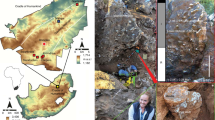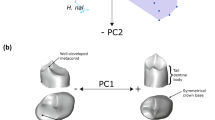Abstract
The description1 of the AL 333-105 cranium from the East African Pliocene provides a new opportunity to re-examine the suggestion2–4 that the Taung child may be a robust rather than a gracile form of early hominid. Comparisons of these two crania with the skulls of living and fossil hominoids indicate that AL 333-105 possesses autapomorphic features associated with paranthropine masticatory hypertrophy, and provide additional evidence for the existence of this lineage in the Hadar Formation. Here, I report a study of the facial morphology of the Taung specimen which, together with recent observations on its dentition5, provides strong evidence against the allocation of the Taung child to the Paranthropus clade. The identity of the specimen is recognized as being in the Homo lineage.
This is a preview of subscription content, access via your institution
Access options
Subscribe to this journal
Receive 51 print issues and online access
$199.00 per year
only $3.90 per issue
Buy this article
- Purchase on Springer Link
- Instant access to full article PDF
Prices may be subject to local taxes which are calculated during checkout
Similar content being viewed by others
References
Kimbel, W. H., Johanson, D. C. & Coppens, Y. Am. J. phys. Anthrop. 57, 453–499 (1982).
Tobias, P. V. Nature 250, 79–83 (1973).
Tobias, P. V. in Early Hominids of Africa (ed. Jolly, C.) 45–84 (Duckworth, London, 1978).
Tobias, P. V. in Current Argument on Early Man (ed. Konigsson, L.-K.) 86–113 (Pergamon, Oxford, 1980).
Grine, F. E. Ann. Transv. Mus. 33, 165–239 (1982).
Pilbeam, D. Nature 295, 232–234 (1982).
Williams, P. L. & Warwick, R. Gray's Anatomy 36th edn (Saunders, Philadelphia, 1980).
Shapiro, H. L. Anthrop. Pap. Am. Mus. nat. Hist. 31 (1), 1–120 (1929).
Endo, B. J. Fac. Sci. Tokyo Univ.(Sect. V: Anthrop.) 3, 1–106 (1966).
Rak, Y. The Australopithecine Face (Academic, London, (1983).
Russell, M. D. thesis, Univ. Michigan, Ann Arbor (1983).
Robinson, J. T. Evolution 8, 324–334 (1954).
Tobias, P. V. in Olduvai Gorge II (ed. Leakey, L. S. B.) 1–64 (Cambridge University Press, 1967).
Olson, T. R. in Aspects of Human Evolution (ed. Stringer, C. B.) 99–128 (Taylor & Francis, London, 1981).
Olson, T. R. in Ancestors: The Hard Evidence (ed. Delson, E.) 102–119 (Liss, New York, 1985).
Holloway, R. L. Nature 303, 420–422 (1983).
Falk, D. & Conroy, G. C. Nature 306, 779–781 (1983).
Johanson, D. C. & White, T. D. Science 202, 321–330 (1979).
Hollinshead, W. H. Anatomy for Surgeons III (Harper & Row, Philadelphia, 1982).
Olson, T. R. Nature 285, 85 (1974).
Author information
Authors and Affiliations
Rights and permissions
About this article
Cite this article
Olson, T. Taxonomic affinities of the immature hominid crania from Hadar and Taung. Nature 316, 539–540 (1985). https://doi.org/10.1038/316539a0
Received:
Accepted:
Published:
Issue Date:
DOI: https://doi.org/10.1038/316539a0
This article is cited by
-
Molecular and morphological congruence in hominoid trans-species polymorphisms
Human Evolution (1995)
-
Nasal region polymorphism frequencies in the FrankfurtPan troglodytes verus collection
Human Evolution (1988)
Comments
By submitting a comment you agree to abide by our Terms and Community Guidelines. If you find something abusive or that does not comply with our terms or guidelines please flag it as inappropriate.



